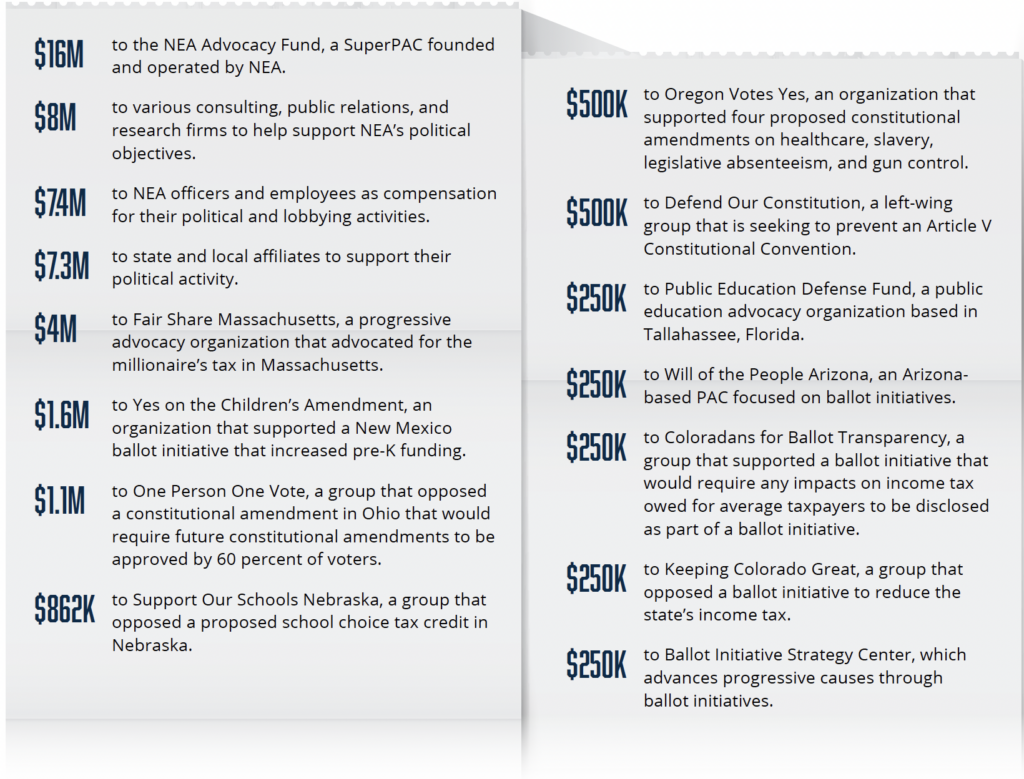A Look at the National Education Association’s Spending, 2022-2023
The National Education Association (NEA) represents over 2.8 million teachers throughout the country. Since the COVID-19 pandemic, NEA has taken on a prominent role in political and cultural debates. As a labor union that represents both public and private sector employees, NEA files a Form LM-2 financial disclosure with the United States Department of Labor. An examination of the union’s finances can help explain its political priorities.
NEA’s latest financial filing, which covers September 1, 2022, through August 31, 2023, shows that the union spent $10 million more on politics and lobbying than it did representing its members. While NEA’s representational spending increased by about $2 million when compared to the previous reporting period, spending on politics and lobbying increased by $8.5 million.
With political spending exceeding representational spending and additional political activity disguised as charitable giving, it is no wonder NEA is losing members. The union lost 14,205 members over the most recent reporting period and has lost a total of 51,987 members since 2021. As such, the union is increasing its dues to offset the financial impact of these membership losses. Membership dues increased by $2 per member when compared to the previous reporting period. As membership declines, NEA members can continue to expect increasing dues.
The union is in a solid financial position, holding $375 million in assets and $56 million in liabilities, good for a net financial position of $318.7 million. Additionally, NEA took in approximately $10 million more than it spent during 2022– While NEA’s net position remains strong, the union’s net assets have decreased by $29.2 million since 2021.
NEA’s revenue totaled $529.5 million during 2022–23, with $374.2 million coming from membership dues and $135.3 million coming from the sale of investments and fixed assets —things like stocks, bonds, and index funds. In the 2022–23 reporting period, all this revenue came from selling Bank of America securities.
NEA spent $519.3 million in 2022–23, down from $572 million during the last reporting period. “Contributions, gifts, and grants” was the largest expenditure category, representing 24.3 percent of total expenditures, followed by the purchase of investments and fixed assets at 22.3 percent. Union operating expenses captured in three categories (general overhead, union administration, and union employee benefits) combined to account for 34.7 percent of NEA’s expenditures.
Employee salaries make up a significant portion of NEA’s operating expenses. NEA President Rebecca Pringle earned $495,787 during the 2022–23 reporting period, about 8.5 times more than the average public school teacher. Pringle’s salary has increased by over $64,000 since becoming NEA president in 2021. Other top earners include Secretary-Treasurer Noel Candelaria ($400,004) and Vice President Princess Moss ($397,325).
Representational activities, the spending category most directly related to labor representation, only accounted for $39.2 million, or 7.5 percent of NEA’s expenditures in 2022– 23. Reported spending on political activities and lobbying accounted for $50.1 million, though the union hid additional political spending in the “contributions, gifts, and grants” category.
Let’s Get Connected
We offer a free membership program, networking opportunities, and professional development scholarships to support qualifying public employees. Sign up today to receive updates from our team.
Who Is Getting Your NEA Dues Money?

NEA Spends Member Dues on Politics
NEA’s reported political spending totaled $50.1 million during the latest fiscal year, though the true number is much higher than this. During the most recent reporting period, NEA reported spending $126.3 million on “contributions, gifts, and grants,” which is where most unions report charitable giving. However, a closer look at the union’s “contributions, gifts, and grants” shows that NEA is directing more money towards political causes than it reports. Here are just a few examples of political spending NEA included in its “contributions, gifts, and grants” expense category:

The Janus v. AFSCME Supreme Court decision relieves nonmembers from the obligation to pay any dues or fees to the union as a condition of public employment. However, for teachers who remain NEA members, Janus changes nothing about how unions spend membership dues: unions spend dues on politics. In 2023, NEA’s political spending included the following:
